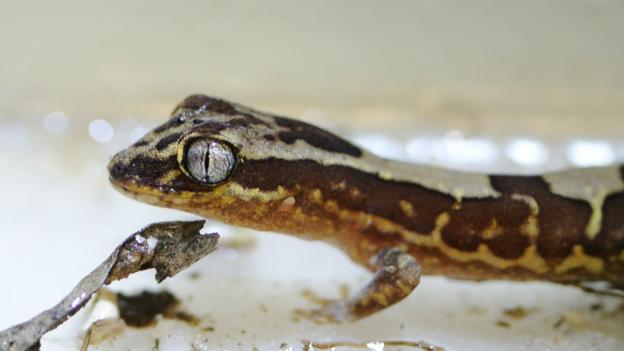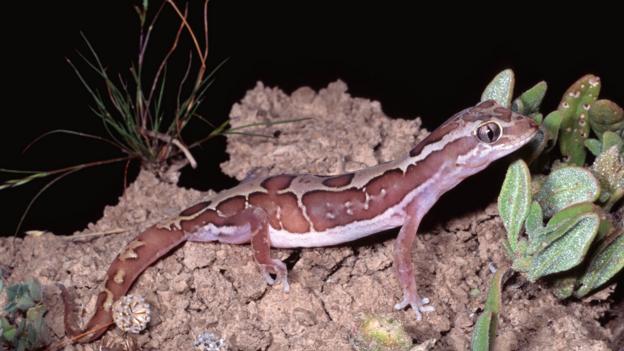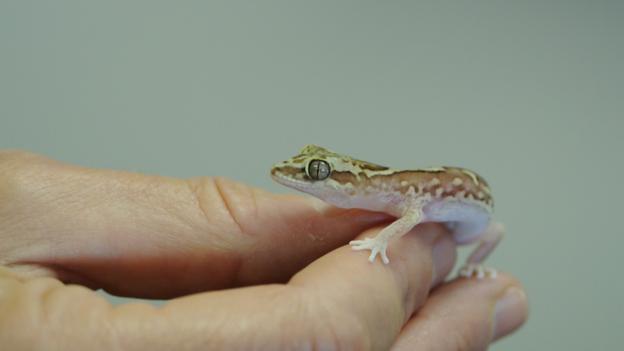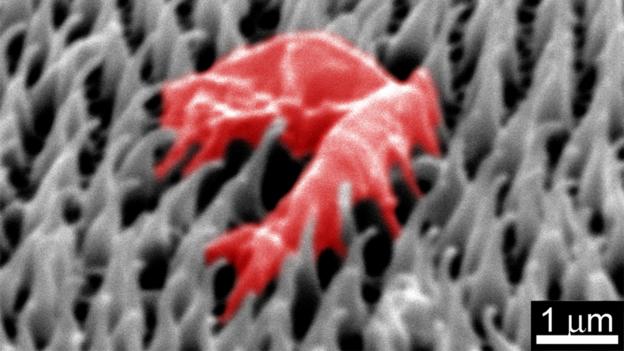The animal with the amazing skin...

Jolanta Watson removes a box-patterned gecko from her freezer and places it on the lab bench. Its whole body is cold, surrounded by humid Australian air. Condensation starts to form. Glinting water droplets adorn the dead lizard’s body. Then they start to jump.
“Come and have a look at this!” Jolanta says to her husband and collaborator, Greg Watson. “This is self-propulsion off the gecko skin.” The water droplets bounce from the surface of the skin like popcorn in a hot pan.
The husband-and-wife team from the University of the Sunshine Coast in Queensland weren’t expecting this. But they had seen something like it before.
The water droplets bounce from the surface of the skin like popcorn in a hot pan
Over the past five years, the two researchers have described a similar ‘bubble dance’ on the wings of insects and the leaves of lotus plants. These so-called “superhydrophobic” surfaces repel water like nothing else in nature.
And in a study published in 2015, they found that this is just one trick of gecko skin. It’s actually a multi-use surface that could inspire us to improve our own materials. “Nature’s already got this abundance of free technology from evolution, so why not use it?” Greg says.
With splotches of dark brown and tan covering their bodies, box-patterned geckos look like lizards in giraffe’s clothing.
Unable to penetrate to the skin below, larger droplets simply roll off the gecko
They live in the deserts and arid regions of eastern South Australia where night-time temperatures drop below the dew point. This means that, without protection, their skin would routinely become covered in a thin film of water – a breeding ground for harmful fungi and bacteria.
But, somehow, the geckos escape that fate. After seeing the “bubble dance” with the gecko on their lab desk, the Watsons took a closer look at small samples of the gecko’s skin as well as any shed skins they could get their hands on. “We try to limit the amount of animals we actually kill,” says Greg.
Under their electron microscope, the Watsons and their colleague Bronwen Cribb could see that the surface of the gecko formed a complex topography of rounded scales carpeted with tiny hairs, or ‘spinules’. Spaced less than one thousandth of a millimetre apart, these hairs form a microscopic bed of nails.
When water sits on the gecko skin it is really resting on the tips of all of those spinules. Most of the water droplet isn’t in contact with the skin at all but with the pockets of air trapped between the spinules. Because of this, the droplets don’t flatten out and spread over the skin: instead they remain almost spherical, as they are when they fall through air.
Unable to penetrate to the skin below, larger droplets simply roll off the gecko, aided by any movement or the force of gravity. But smaller droplets do something else.
“They don’t have as much mass so they don’t have as much influence with gravity,” says Greg. “So they can potentially wet the lizard because they’re so small.”
This is where the ‘bubble dance’ comes in.
Luckily for the box-patterned geckos, small water droplets simply and automatically jump from their backs. The lizards do not have to do anything; it is an autonomous quality of small water droplets.
The hairs seem to kill the bacteria
Here’s how it works. When two small droplets merge, their total combined volume remains constant – but the overall surface area of the larger droplet is smaller than the combined surface area of the two smaller droplets.
This leads to a change in surface energy which then has to go somewhere, Greg says. And the large majority is translated into kinetic energy – the droplet self-propels away in a phenomenon that the Watsons dubbed “geckovescence”.
Together with the rolling of larger droplets, this ‘bubble dance’ also removes any contaminants from the lizard’s back. In other words, gecko skin is unwettable and self-cleaning.
It is also inherently antibacterial. By using a stain that makes living bacterial cells glow green and dead cells glow red, the Watsons and their colleague David Green could track how certain bacterial strains fared once placed on gecko skin.
Under their microscopes, the cells were red. They were dead. “The hairs seem to kill the bacteria not with chemistry or anything, but [they] seem to penetrate the bacteria,” Greg says. Although it is lethal to microbes, larger cells – such as human stem cells – are not harmed by this spiky surface.
Gecko skin is unwettable and self-cleaning
“We’re now looking into mimicking this arrangement,” Greg says. Such a bio-inspired surface would allow the growth of human or other animal cells in culture, but prevent the accumulation of any unwanted bacterial residents. And because no chemicals are involved, bacteria may find it very hard to build up resistance against this physical antibiotic.
However, these potential technological spin-offs are not the reason Greg and Jolanta do what they do. They are simply curious about the natural world that surrounds them, and how it works.
Their freezer is an emblem of their curiosity. One side is dedicated to their foodstuffs. The other contains snakes, snakeskins, butterflies, beetles, millipedes, and various lizards; all waiting for a closer inspection when the two researchers find the time away from their administrative and writing duties.
“There are a lot of pressures now, where you have to publish or perish, so to speak,” says Jolanta. “But Greg and I have a very firm philosophy that science is about discovery and just basic human curiosity.”
“A lot of our projects just come about from really never growing up,” she says. “We’re always at that five-year-old stage, where we pick things up and we look at them.”
bbc.com
The animal with the amazing skin...
![]() Reviewed by Unknown
on
1:32:00 AM
Rating:
Reviewed by Unknown
on
1:32:00 AM
Rating:








